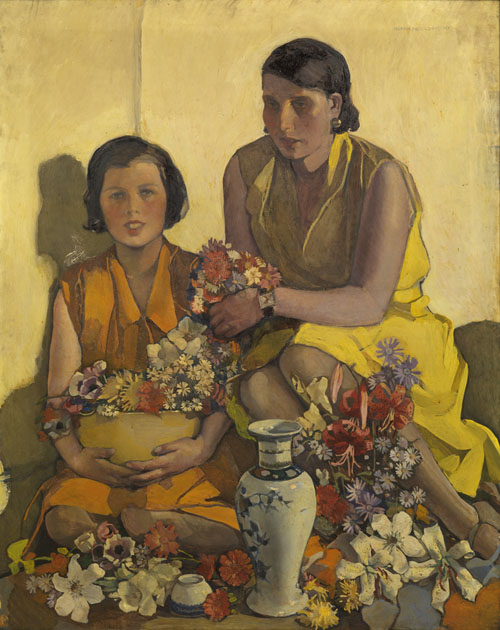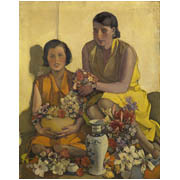Details
- Object type
painting
- Title
Salopian Cup and Chinese Vase
- Artist/Maker
Norah Neilson Gray artist
- Culture/School
Glasgow Girls
- Date
circa 1930
- Materials
oil on canvas
- Dimensions
framed: 1380 mm x 1127 mm x 50 mm; unframed: 1270 mm x 1016 mm
- Description
-
A decorative painting of two women, one sitting on a low stool, with a younger girl seated on the ground, surrounded by flowers and ceramics. The predominant colour is yellow. The women wear yellow, the walls and floor are yellow, and the bowl the younger girl holds is yellow.
Norah Neilson Gray was a painter and fashion plate designer, one of a group of female artists trained at Glasgow School of Art that became known as the ‘Glasgow Girls’, following the adoption of the term ‘Glasgow Boys’ to describe their male counterparts. Born in Helensburgh, Gray was the second youngest of seven children of a Glasgow shipowner, George Gray, and Norah Neilson, from a Falkirk auctioneering family. Her sisters Muriel and Tina also became notable professionals in their field, Muriel lecturing in English at Glasgow University, only the second woman to be appointed to their staff at that time, and Tina becoming a surgeon, after working as a Voluntary Aid Detachment Nurse in World War I. All three girls remained unmarried.
Norah Neilson Gray initially attended a private drawing studio in Craigendoran, just outside Helensburgh, run by the Misses Ross and Park – Glasgow Boys John Lavery and Alexander Roche were visiting artists there. From 1901 until 1906 she studied at Glasgow School of Art under Belgian Symbolist Jean Delville, who was considered rather daring and decadent. After graduating she joined the staff at Glasgow School of Art, teaching fashion design and drawing. She also taught at St Columba’s School in Kilmacolm where she was known as ‘Purple Patch’ because she would ask students to look for colour in shadows. She first exhibited at the Royal Academy in London while she was still a student and had her first one-woman exhibition at Warneuke’s Gallery in Glasgow in 1910, where she involved herself in the interior decoration, toning down the walls and gold of frames, concerned about the total effect. She was a strong woman, not afraid to assert own mind. In this year she acquired her own studio at 141 Bath Street.
Gray became particularly well known for intimate and decorative portraits of women and children. This painting depicts the artist’s nieces, daughters of her elder sister Gertrude (Gertie): on the left Norah G. A. Wilson (later Mrs Armour); and on the right her sister Graeme H. Wilson (later Mrs George McOwan). Gray described herself as ‘desperately interested in people’s faces’ (letter to E. A. Taylor, 7 October 1912). Her portraits are typified by restraint and a tender wistfulness. They are also very decorative, concerned with the beauty of colour and compositional balance. Some contemporaries criticised her paintings as too decorative, full of flowers, textiles and other decorative elements. The flowers in this painting are also symbolic: lilies relating to birth, motherhood, and purity; daisies to innocence and gentleness; and anemones to unfading love). The term ‘Salopian’ in the title means relating to Shropshire.
Gray died from cancer in 1931 at the age of 49, at height of her success. A year before her death the ‘Glasgow News’ wrote: ‘It is sometimes remarked that women painters do not attain the same strength and sureness of power which characterises men. It may be suggested also that, after centuries of men painters and men critics of painting, it is not surprising that the man’s point of view is dominant […] Whatever may have been the prejudice against women painters, Miss Neilson Gray has been able to overcome it, for her works are in galleries of Paris, Brussels, Nice and Toronto, as well as those of Great Britain and Ireland, and she is well ‘hung’ in the Royal Academy, the International Society of Sculptors, Painters and Engravers, the National Portrait Society, the Salon des Artistes Français, and the Beaux more
- Credit Line/Donor
Bequeathed by Mrs Norah Armour, 1991
- ID Number
3477
- Location
Kelvingrove Picture Promenade


